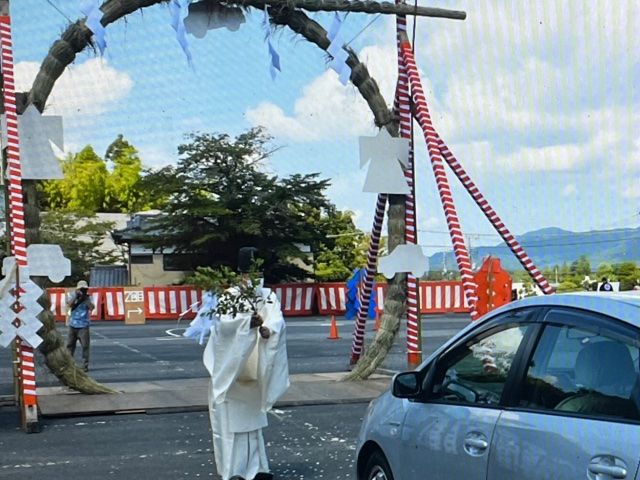
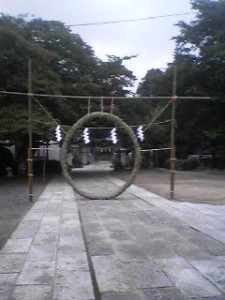

By Avi Landau
Historically, the summer months were a time in which the inhabitants of the Japanese isles were susceptible to sickness and epidemics were like;y to break out. The month-long rainy season often led to flooding, which was then followed by almost two months of intense heat and humidity. Perfect conditions for the incubation and spread of deadly bacteria. In modern times, government sponsorship of vaccination programs, and the very successful propagation of the rules of hygiene among the general public have pretty much put an end to the health hazards of summer. The early Japanese state had no recourse to modern medicine. It did, however, introduce a nation-wide government sponsored program with the aim of protecting the health of the populace living under its domain. In the Nara Period (710-794), the Japanese Court proclaimed that each year, two official purification rites be held for the physical and spiritual welfare of its subjects. One was to be held in June (夏越の祓、nagoshi no harae) and the other in December (年越の祓toshikoshi no harae).
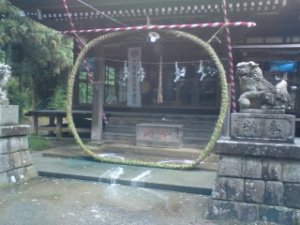
The summer rites often, but not always, featured the use of a large ring, made of reeds or straw, through which those seeking purification would walk. The belief in the purifying powers of these vertical rings derives from a story in Japanese mythology in which the God Susanoo no Mikoto advises a poor man who has helped him, to weave a ring of reeds (cotton-grass) and wear it around his waist to protect himself from an imminent epidemic. The man survived, and the ring’s reputation born. The passing-through-the-ring ceremony is usually called CHINOWA KUGURI (茅の輪くぐり), but in Ibaraki you will hear WAKUGURI more often.
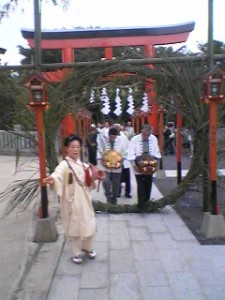
You have a chance to witness or undergo this ancient rite this coming Tuesday, June 28th at the Kaba-San Shrine (加波山神社, kabasan Jinja), just past Mt. Tsukuba, near Makabe. Things will get underway at 11:00 with a traditional sword drawing ritual (as you might know, swords have great powers of exorcism and purification in Japan). The sword cuts through the air with a haunting WHOOSH, scaring off any lingering evil. The procession through the ring is then led by the priest and a conch blower (the sound of this large shell is also known for its exorcistic powers!) and 2 men holding lion masks. After passing through the ring three times, the priest begins a purification ritual (o-harai),which takes about 30 minutes and culminates in the dispensing of sacred sake(omiki)to all the participants. Later papers with the names and ages of worshippers written on them are released into a stream near the summit of Mt. Kaba.
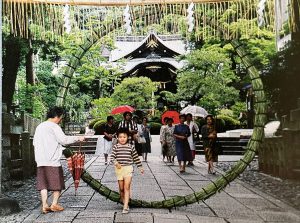
There are actually 3 shrines called kaba-San Jinja at present. The first one you come to after turning off the main road also has a ring set up,but there is no special ceremony (this shrine should also be visited if you make the trip to Mt Kaba.The Shrine I am discussing in the present article is a little further up the road, just next to the small Tobbaco Shrine. It CAN’T be missed as it is big, red and gaudy. In fact I cant recall having seen such a shrine in Japan. The decorative motifs are much more reminiscent of Singapore, a mix of Indian and Chinese. The ring itself, made of CHIGAYA (cotton-grass), also suggests that this custom might have Pacific island origins (though the ring might be made of straw or even bamboo, depending on the region)..
Mt. Kaba itself is well worth a visit anytime, for its nature, shrines and for its historical significance. You might not associate Ibaraki with political radicalism, but in fact, this region has long been associated with violent HOT-HEADS, going all the way back to the rebel Taira no Masakado, the man who tried to take control of this area and create an independent kingdom before being captured and beheaded in the late 10th century. Almost a thousand years later, in 1884, radical activists of the Freedom and People’s Rights Movement (JIYU MINKEN UNDO, 自由民権運動), inspired by the assassination of the Russian Tsar, conceived a plan to strike at Japanese politicians and business leaders with home-made bombs. Their plan to set off bombs at a meeting in Utsunomiya in Tochigi was discovered and 16 of the plotters headed for the hills. In this case they fled to Mt Kaba. Battles ensued with a number of casualties on both sides.
This was on of many such incidents that took place during that period (the 1880’s), the most famous of which is probably the 1884 Chichibu Incident.
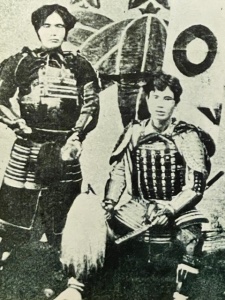
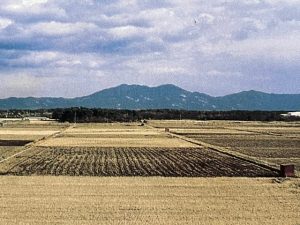
If you have no time for chinowa kuguri this weekend, you will have a second chance, right here in Tsukuba, at the end of next month. See another article I’ve written: The Ancient Rite Of Chinowa-Kuguri at Tsukuba’s Hie Shrine.
If you travel around Japan in the summer and visit some shrines, it is very likely that you will see these rings of straw set up on the path leading to the main hall. Now you will know what they are, and what they are for.
